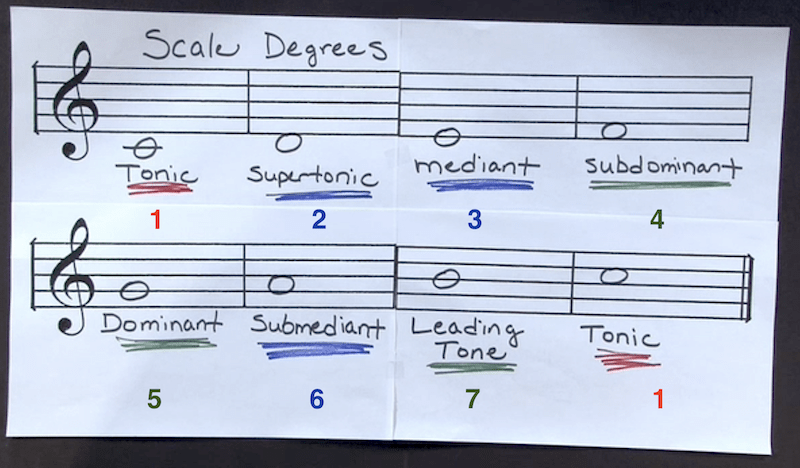
Summary
The goal of this project is to improve understanding of musical techniques used to engage the listener and harness certain features. Learning to do these things effectively can be important to musicians who strongly value being understood amongst a large audience. I did this through creating and experimenting with melody forms using hooktheory, and by referencing songs whose melody I enjoyed.
My First HookTheory Melody

Notes from Howard Goodall’s Melody Video
| Cue | Notes |
| How did cultures go about developing more notes once progressing past pentatonic notes? Why have humans not come to a global consensus on how many tones to use on a scale? What impacts the decision that causes scale length to vary? | – All music “uses the same baseline” – Some melodic principles are universal to every culture around the world – Every music system uses the same five notes- instincts for language and frequencies seem to have been instilled in us since birth—” these five notes are like a human inheritance”—pentatonic notes– – Tone variation is impacted by culture -Movement between whole tone to whole tone is more common (especially vocally) because more people struggle with transitioning from whole tones to half-steps/ semitones. – Note groups-scales are called modes – Modes—moods in different cultures – Across all frequencies we pick notes and assign moods/feelings—these are called modes – Sharpening—raising by a semitone/half step—yearning/reaching – In declination, modes are left without alteration/sharpening—this later started to lead to lowering/flattening. False relations occur when these alterations are overlapped. – The melodic modifications applied to the vocals of different genres can be cultural–blue notes– – Standardized tuning–diatonic tuning gives people the option to join frequencies that complement each other – Ionian-major scale minor scale designed to be compatible with major leaving room for a smooth transition between the two – Identifying which mood is intended to be channeled before assembling a song could help establish a starting point through modes. – Jewish melody was crucial to creating the foundation of American broadway-style music. ————————————– tonic-tonic –closed off phrase no tension tonic-dominant–tonic—high tension–demands the second phrase to resolve tension submediant–not high tension/not tonic focus on creating patterns |
Summary: The overarching idea I was able to take from the video was that humans are naturally attracted to certain sounds, tones, and frequencies. This causes them to reappear within different cultures and ultimately influence those listening, even subconsciously.
Melody Composition Terms and Definitions

- The terms and definitions below are from the Basic Concepts of Music Theory podcast by Jamie Henke at the University of Wisconsin-Madison
- Her Basic Concepts of Music Theory video on YouTube
- Theme: A long, flowing melodic idea.
- Motive: A short, rhythmic idea (Beethoven’s 5th).
- Period: 8-12 measures or a musical sentence.
- Phrase: Usually 4 measures.
- Antecedent (Question) Phrase: First 4 measures of a period.
- Consequent (Answer) Phrase: Second 4 measures of a period.
- Scale Degrees (C Major Scale)
- Tonic: C (1 , 8) – Stability and resolve.
- Supertonic, Mediant, Submediant: D, E, A (2 , 3 , 6) – Moderate tension, useful for transitions and carrying on an idea.
- Subdominant, Dominant, Leading Tone: F, G, B (4 , 5 , 7) – Causes the most tension, leads to the tonic.
- Steps: Any movement using half or whole steps.
- Leaps: Any movement using intervals larger than a whole step.
- Conjunct motion: Melody is built primarily out of steps.
- Disjunct motion: Melody is built primarily out of leaps.
- Repetition: Repeated material (i.e. motive) used to create a link between two phrases of the period.
- Contrast: Two phrases that contain contrasting material to create tension and interest.
- Variation: Halfway between contrast and repetition. The two phrases include some recognizable material and some varied material (i.e. taking ideas up an octave).
One of My Favorite Melodies

I like this melody because of how simple it is. It does not vary much and this makes the contrast more apparent. The behavior of the melody above reflects in the screenshot as fairly “grounded”. I think of this as a charming thing because of how familiar and comforting it feels due to the use of repetition, while also expressing conflicting feelings of somberness and positivity in its slight variation. This song is in the key of B, with D# as its tonic note, and E as its dominant.
My Second HookTheory Melody
What I Learned & Problems I Solved
This project helped me learn more about the technical terms which I’m not too familiar with, and often forget. Directly applying it allowed me to adjust my perspective on developing melodies in order to properly resolve and raise tension. I often favor patterns of high tension and low resolve, i don’t necessarily see this as a problem, but I do think it becomes a creative issue. While I haven’t completely reformed my preferences for this project, I was able to form respect for the pattern/formulas that result in favorable melodies.
